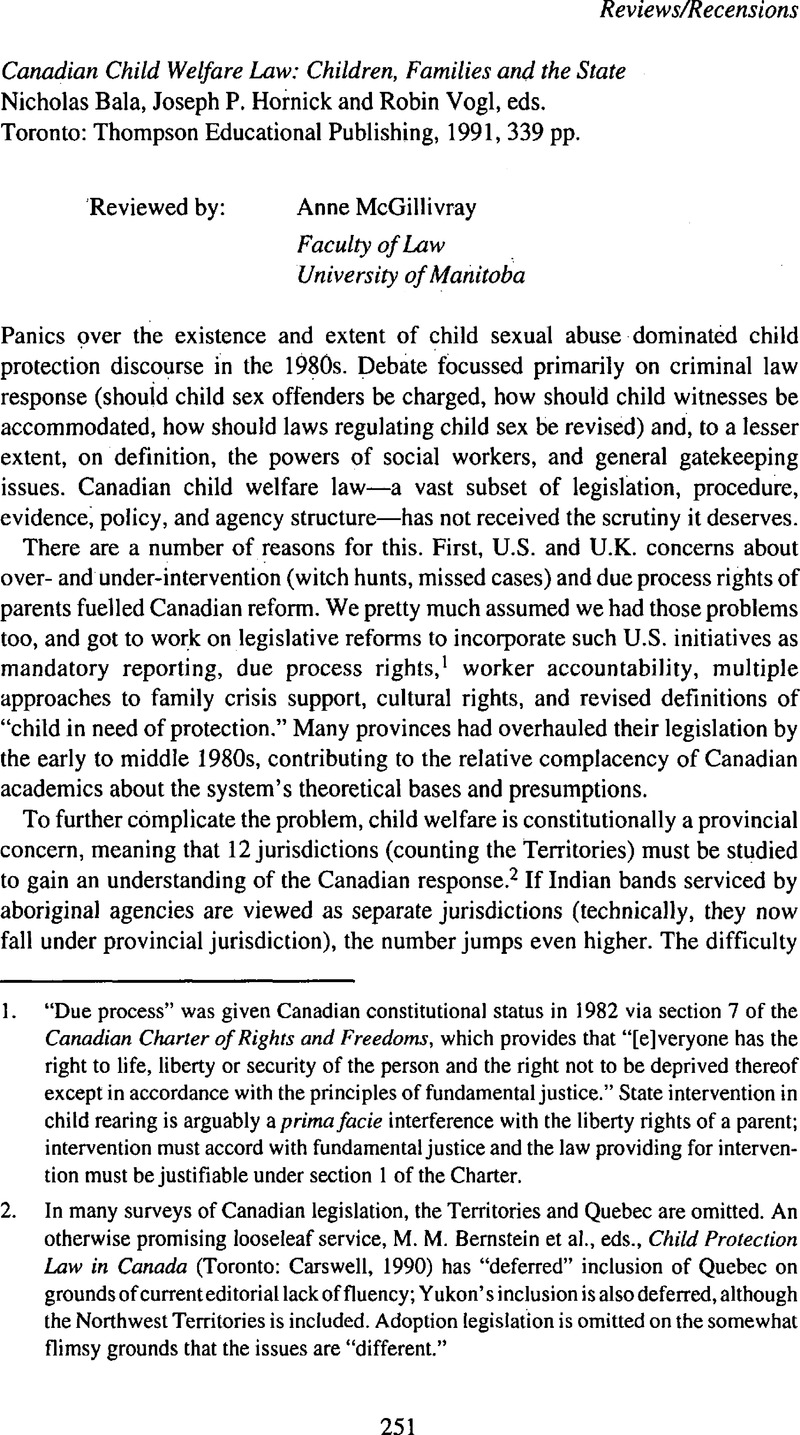No CrossRef data available.
Article contents
Canadian Child Welfare Law: Children, Families and the State, Nicholas Bala, Joseph P. Hornick and Robin Vogl, eds. Toronto: Thompson Educational Publishing, 1991, 339 pp.
Published online by Cambridge University Press: 18 July 2014
Abstract

- Type
- Reviews/Recensions
- Information
- Canadian Journal of Law and Society / La Revue Canadienne Droit et Société , Volume 8 , Issue 2 , Fall/automne 1993 , pp. 251 - 256
- Copyright
- Copyright © Canadian Law and Society Association 1993
References
1. “Due process” was given Canadian constitutional status in 1982 via section 7 of the Canadian Charter of Rights and Freedoms, which provides that “[e]veryone has the right to life, liberty or security of the person and the right not to be deprived thereof except in accordance with the principles of fundamental justice.” State intervention in child rearing is arguably a prima facie interference with the liberty rights of a parent; intervention must accord with fundamental justice and the law providing for intervention must be justifiable under section 1 of the Charter.
2. In many surveys of Canadian legislation, the Territories and Quebec are omitted. An otherwise promising looseleaf service, Bernstein, M. M. et al. , eds., Child Protection Law in Canada (Toronto: Carswell, 1990)Google Scholar has “deferred” inclusion of Quebec on grounds of current editorial lack of fluency; Yukon's inclusion is also deferred, although the Northwest Territories is included. Adoption legislation is omitted on the somewhat flimsy grounds that the issues are “different.”
3. Child protection statutes typically require prediction of future risk in assessing placement options. Prediction of risk is driven less by law or policy than by widely varying worker (and judicial) standards. Although this variation has been criticized in the literature, worker discretion and “open” legislation have typically been considered important tools in child abuse management. Variables in the exercise of discretion and in the success of protective intervention are now being addressed in a University of Manitoba study intended to research and reduce variation in worker judgement and develop a reliable instrument for identifying at-risk children and abusive families.
4. For example, white slavery panics and crowded housing explanations of incest were imported from England to Toronto and Winnipeg (see note 5); J. J. Kelso adopted the U.S. Humane Society model for child protection (and his juvenile court model was appropriated wholesale by U.S. jurisdictions, with authorship until recently in dispute); contemporary backlash draws on U.S. problems and perspectives to critique Canadian state response; and perhaps the child abuse criminalization movement itself, initially a U.S. response that has spread to Canada (culminating in the enactment of Bill C-15, discussed below) and to the U.K.
5. See, inter alia, McGillivray, A., “Reconstructing Child Abuse: Western Definition and Non-Western Experience” in Freeman, M. & Veerman, P., eds., The Ideologies of Children's Rights (Dordrecht: Martinus Nijhoff, 1992) at 213Google Scholar.
6. See Chunn, D., From Punishment to Doing Good: Family Courts and Socialized Justice in Ontario 1890–1940 (Toronto: University of Toronto Press, 1992)Google Scholar; Ursel, J., Private Lives, Public Policy: 100 Years of State Intervention in the Family (Toronto: Women's Press, 1992)Google Scholar; and Valverde, M., The Age of Light, Soap, and Water: Moral Reform in English Canada, 1885–1925 (Toronto: McClelland & Stewart, 1991)Google Scholar. Ursel documents legislative changes affecting child protection in Ontario and Manitoba; Chunn looks at the blurring of civil and criminal remedies in the family courts; Valverde discusses, inter alia, the hygiene movement in Canada, which linked patriotism, science, and morality in fuelling and responding to moral panics about sexual abuse, the regulation of incest, age of consent, and so on, and points out significant differences between the U.S., Britain, and Canada. See also Hooper, C.-A., “Child Sexual Abuse and the Regulation of Women: Variations on a Theme” in Smart, C., ed., Regulating Womanhood: Historical Essays on Marriage, Motherhood and Sexuality (London: Routledge, 1992)Google Scholar.
7. The relationship between aboriginal child welfare management and full self-government is not new. Control of child welfare has been viewed as the first real step toward self-determination at least since the early 1980s. Control of funding, bloodlines, and cultural survival are all implicated. See McGillivray, A., “Transracial Adoption and the Status Indian Child” (1986) 5 C.J.F.L. 437Google Scholar.
8. Director of Child Welfare v. B.B., 14 R.F.L. (3d) 113 (Man. CA); B.B. v. Director of Child and Family Services (1989), 62 Man. R.(2d) 233 at 234 (S.C.C. [1989] W.D.F.L. 967); Monnin JA for the Manitoba Court of Appeal wrote at 114: “I do not accept as sound the principle enunciated by the trial judge that there are certain standards or norms which are acceptable for Easterville but unacceptable for the rest of the province. Economic conditions may differ but there is only one standard of care to be considered and applied.” The Supreme Court rejected that standard, opting instead for one more fluid, more economically appropriate. The court agreed that the children were in need of protection but concluded that statutory family support alternatives had not been adequately considered, and referred the case back to the trial judge. The children were returned to the household, and the agency appealed.
9. See, inter alia, The [Manitoba] Fatalities Inquiries Act Report Respecting the Death of Lester Norman Desjarlais (the Giesbrecht Report, 1992), which discloses evidence of political meddling with aboriginal child protection agencies that left children in highrisk situations. This is (understandably) glossed over in this chapter.
10. See, e.g., McGillivray, A., “Abused Children in the Courts: Adjusting the Scales After Bill C-15” in 1990 Annual Survey of Manitoba Law 150Google Scholar; and The Criminalization of Child Abuse (LL.M. Thesis, University of Toronto, 1988)Google Scholar.


